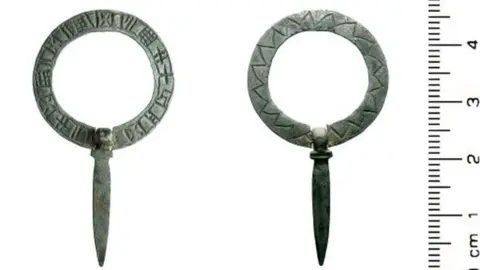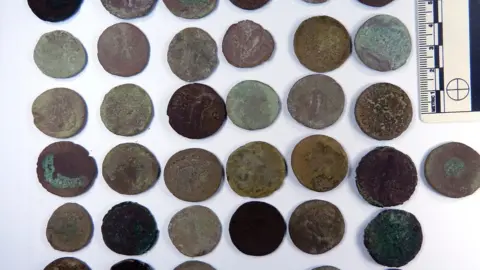Shropshire brooch and coin hoard finds declared treasure
 BRITISH MUSEUM’S PORTABLE ANTIQUITIES SCHEME
BRITISH MUSEUM’S PORTABLE ANTIQUITIES SCHEMEA medieval silver brooch and a hoard of Roman coins have both been declared as treasure.
They were found separately by metal detectorists searching in the north of Shropshire last year.
At inquests held in Shrewsbury's Shirehall on Wednesday, they were both found to be treasure by the coroner.
The county's finds liaison officer, Peter Reavill, said Shropshire Museums Service had now expressed an interest in acquiring both finds.
 BRITISH MUSEUM’S PORTABLE ANTIQUITIES SCHEME
BRITISH MUSEUM’S PORTABLE ANTIQUITIES SCHEMEThe circular brooch, dating from 1150-1400 AD was uncovered near Whittington, and would have been worn by ladies of every rank in the period, Mr Reavill said.
"Although this brooch is small, it is perfectly formed with neat and detailed design," he said.
"The fact that it has survived so well in the Shropshire soil for the past 700 years or so is amazing.
"Although we may never know who owned it - they probably would have missed it and because it has so little wear is most likely to have been lost soon after it had been made."
The coin hoard, uncovered in Holyhurst, near Whitchurch, consists of 37 brass or copper alloy Roman coins, known as dupondii and asses, which would have been deposited during the reign of Emperor Trajan after AD 111, Mr Reavill said.
"The face value of this hoard is low and it represents everyday spending money that Shropshire's resident Romans would have had in their pockets," he added.
"In terms of spending value, a Roman legionary soldier was paid 300 denarii a year - so these coins represent no more than two to three days' legionary pay."
But, he said, despite their low value they were treasure, as they represented "the normal everyday Shropshire past".

Follow BBC West Midlands on Facebook, on Twitter, and sign up for local news updates direct to your phone.
